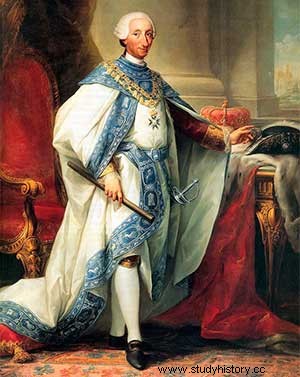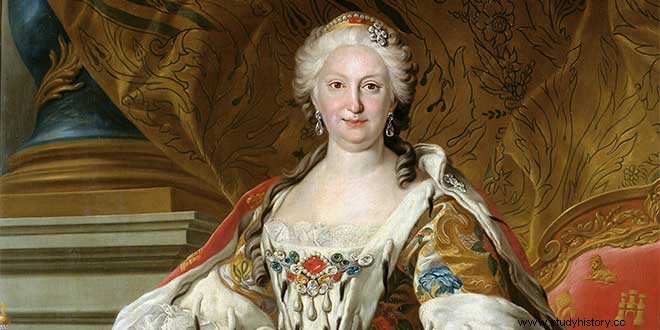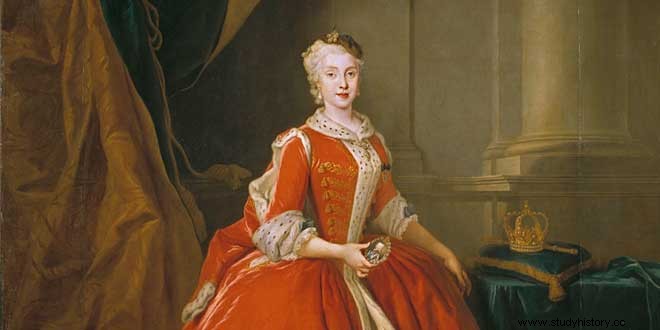Carlos III was king of Spain , maximum representative of the enlightened despotism of the 18th century, Carlos III was the prototype of numerous Spanish liberals who would live in the two following centuries. Empowered by almost three decades of reign in the Two Sicilies and intelligently seconded by a nucleus of efficient and educated ministers related to French emocyclopedism, under his rule Spain was able to experience a brief but intense resurgence, definitive in many aspects. Subjecting it to profound reformism, he laid the foundations for the country, until then in frank decline, to prepare for the immediate advent of capitalism.
Data on the life of Carlos III of Spain
1716 Carlos III de Borbón y Farnesio was born in Madrid.
1731 He receives the title of Duke of Parma, Pías Gum and Guastalla.
1738 He is invested as Charles VII, King of Naples. He married by proxy with Maria Amalia of Saxony.
1759 He is crowned King of Spain, like Carlos III.
1760 His wife, Queen Amalia, dies.
1788 He dies in Madrid. His son Carlos IV, Prince of Asturias, succeeds him on the throne.
During his reign, Spain was able to show his power for the last time. Not only because of the vast extension of his possessions, but because of the cultural and European tone that the monarch imprinted on his renovation initiatives and, in general, on all State acts. The almost three decades of government of King Carlos III are considered by most historians and scholars of the Spanish eighteenth century as an open parenthesis in the midst of the process of decline of the monarchy; and good proof of this was the rapid decline of so much prosperity as soon as death removed him from the throne. Despite his errors, he was the perfect representative of the benevolent despot, and, as an enlightened and illustrious monarch, comparable to his glorious contemporaries Frederick the Great and Joseph II. Like the latter, too, he was undoubtedly a doctrinaire who, influenced by the French encyclopedists and without a deep understanding of the idiosyncrasies of his country, wanted to implement reforms on several occasions, but they were foreign and difficult to take root in the Spanish circumstances. However, it must be admitted that, in many ways, Carlos III was the prototype of many Spanish liberals who would live in the following two centuries.
The fruit of ambition

First-born of the marriage formed by Felipe V de Borbón, the first monarch of this dynasty that occupied the Spanish throne, and his second wife, Isabel Farnesio, Carlos III was born on January 20, 1716 in Madrid , in the old fortress of the Austrias. Despite the adjectives "robust" and "beautiful" with which the Madrid Gazette announced the event, in the face of that new blond and pale offspring, small and decidedly unattractive, no one could suspect that he would shine more brilliantly than many of his ancestors, contemporaries and successors. No one except the queen as she obsessively devoted all her efforts to achieve it. The children of the king's first marriage to María Luisa Gabriela de Saboya, Luis, Prince of Asturias, and the infantes Felipe and Fernando, held an indisputable right of preference in the inheritance of the crown of Spain; however, the efforts of Isabel Farnesio above all, and chance on the other hand, were going to modify the foreseen future.
Meanwhile, the childhood of Carlos III developed without notable features. Shy, quiet and obedient; half-hidden between the limelight of his half-siblings and his immediate younger siblings, he seemed even more diminutive. The premature death of the infant Felipe, in 1719, did not alter the queen's plans. She knew that, as long as they lived, the two remaining stepsons remained the legitimate successors to the throne, and, at the moment, there was nothing to foresee her death. Therefore, he initiated, through his minister Count Alberoni, a revisionist policy of the Treaty of Utrecht , for which Philip V had lost all his Italian possessions. His goal was to recover them to be governed by his sons, and, taking the achievement for sure, he subjected his eldest son to intensive learning of the Neapolitan, Lombard and Florentine dialects, which meant for the little one an almost absolute dedication to study, since In addition, he received elementary education in Spanish and French, entrusted to Father Laubrusel, who had come from France at the request of Isabel Farnese. Alberoni already deposed, it was Baron Ripperdá who managed the Treaty of Vienna signed in 1725, which confirmed the investiture of Carlos as Duke of Parma and Plasencia. But England, France, Holland and Prussia were opposed, signing in turn a new treaty in Hannover. The queen lived that year upset by the abdication of Felipe V in favor of her stepson Luis, who reigned as Luis I for a brief period of seven months. Upon the death of the young sovereign, who, affected by smallpox, ceased to exist at the age of seventeen, I harbor new hopes. Although Felipe V accuses unequivocal symptoms of insanity, Isabel prevented Fernando, the only living stepson, from succeeding the king, and forced her husband to retake the throne:in reality, the most skillful and least compromised way of continuing to exercise the power
Thecourtofmiracles
With the help of destiny, her ambition and the invaluable collaboration of her ministers, Isabel Farnesio would see each of her maternal dreams fulfilled as if by a miracle. Two of his stepchildren having already died, the remaining one practically isolated from the court, and exercising absolute dominance over the unbalanced Felipe V, it can be inferred that the second reign of the first Bourbon gave him complete freedom of action to achieve the realization of his designs. It is due to her, then, that this long period is characterized by an intense foreign policy, treaties, agreements and family pacts, sometimes to the detriment of the true interests of the country, but always in favor of her own and costly interests. Thus, through the Treaty of Seville, signed on November 9, 1729 between Spain, France and England , it was agreed that the Spanish forces would occupy Plasencia, Parma and Tuscany to ensure the succession of Carlos, in exchange for giving Gibraltar once again without regard. Finally, in June 1731, when the Duke of Parma Antonio Farnese died, a declaration was signed recognizing him as his successor; on July 25 the declaration is confirmed in Florence by the emperor. On October 20, Carlos III left Seville and at the end of the year he arrived in Leghorn, where the brand new fifteen-year-old duke was received with all honors.
At the initiative of Louis XV, the French monarch and Felipe signed the first Family Pact on November 7, 1733; the queen was no stranger to it. It was about uniting both armies to expel the Germans from the Two Sicilies and award the throne to Carlos. The young duke was suddenly immersed in a feud hatched by his mother in which everyone seemed to have an interest:France wanted Lorraine for itself; the Sardinians, Lombardy, and Spain, the crown of Naples. Appointed generalissimo, he left in 1734 with the Duke of Montemar and the Count of Clavijo, and on May 10 he entered Naples victorious. He soon beats Viceroy Visconti at Bitonto, takes Gaeta and Capua. On May 18, 1736 the emperor, through the Vienna Peace Agreement, renounced all his rights over Naples and Sicily in favor of Carlos, in exchange for the rights of Parma and Plasencia. The change admitted no doubts:that luminous kingdom was well worth it, which, at the age of eighteen, completely captured him. Isabel would not rest until she recovered the duchies for the infant Felipe. Carlos, converted into Charles VII of Naples, would reign for more than a quarter of a century .

In the spring of 1738, Carlos contracted a marriage by proxy with Princess Maria Amalia of Saxony; but the future queen, despite her obvious physical development, had not yet shown signs of puberty at twelve years of age, so they had to wait until the following year to consummate the union. (The Simancas Archive keeps the numerous correspondence of Carlos, in one of whose letters he recounts to his parents, with prolixity and luxury of details, the first loving contact with his wife.) Already united, from mid-1738, they would come to conceive, during the two decades that the marriage lasted, thirteen children. Although only related in the fourth degree, however, only seven would survive, and of these, the first two males showed marked psychic decline. The eldest son, eventually Duke of Calabria, revealed from an early age his lack of restraint that made all hope vain; As an adult, he became a dangerous nymphomaniac who threatened the virtue of any woman within his reach. The second, although of robust and healthy complexion, suffered from an unusual lack of intelligence, and if he grew older he acquired some criteria, since his father did not let him interfere in any government affairs, he turned out to be a mediocre Prince of Asturias. Married at fourteen to his cousin María Luisa de Parma, she dominated him from day one. Later, when he succeeded his progenitor on the Spanish throne as Carlos IV, his indolence hastened the decline of the Bourbons. Despite this alarming reluctance, he was the most prolific of them all, as he had twenty-two children.
While Carlos VII ruled the peaceful Neapolitan kingdom, changes were happening in Madrid. In 1743 the second Family Pact with France was signed, and the incursion into the War of the Austrian Succession finally gave, through the Peace of Aachen in 1748, the sovereignty of the dukedoms to his brother Felipe. On July 9, 1746, after the death of his father, Fernando VI succeeded him, but the death of his wife, Bárbara de Braganza precipitated his own death in Villaviciosa, on August 10, 1759. While his mother assumed the regency, the kings of Naples undertake the trip to Spain to take charge of government. In Naples the crown fell on Fernando IV, third son and first in
the wisdom of him, under the tutelage of Minister Tanucci, since the new king was eight years old.
Spain awaited the arrival of the new monarchs with mixed feelings. If when anchoring in the Barcelonian port they were received with salvos launched from Montjuïc, in Madrid they were received with some suspicion. They mistrusted a king who, at forty-three, had spent twenty-eight abroad. Queen Amalia, for her part, suffered for having had to leave her beautiful villa facing the Tyrrhenian for "a land where all barbarism, arrogance, contempt for that which is proper to good taste," according to her letter to her minister Tanucci. The Madrid of those days vanished any possible comparison with European capitals. Nor did the new queen like her mother-in-law, who, installed again in the palace, was willing to intervene in the decisions of the kingdom. Elizabeth had acquired the habit, through the madness of her husband, of making day night and night day, which was, moreover, a nuisance to the court. Everything would have a remedy. If Carlos III differed from his immediate predecessors —and successors— in anything, it was that he never tolerated feminine influences. His mother was separated from him and his wife died shortly after settling in Madrid, on September 19 of the following year, 1760 .
Carlos III was then at the height of his life. He had great experience of men and the affairs of government and was to reign for another twenty-nine years. He never remarried and of his two confessed loves of his, the queen and the hunt, he dedicated his widowhood to the one he had left.

Only towards the end of his life did his health fail, for he was a healthy man, spending most of his time in the open air. Persuasive rather than authoritarian, he inspired fear in his ministers, despite arousing admiration for his self-control and gentleness. His long stay in Neapolitan had endowed him with a great sense of humor and a very Italian insight. In Spain he was, with the possible exception of his descendant Alfonso XIII, the most cosmopolitan of the Bourbons. But he knew little about his country, and events were going to prove it. He had a heavy hand, however. First with his Italian ministers, Grimaldi and Esquilache; Later, supported by Floridablanca and the Count of Aranda, he led an active and radical domestic and foreign policy. He put down the riots and expelled the Jesuits when they opposed his decision to turn the Church into a mere department of state. He also counteracted rural depopulation, reformed and unified the currency, founded hospitals, asylums and charity houses throughout the country, savings banks and charitable institutions. He promoted industry and, contrary to the neutralist ideas of his predecessor, rebuilt and increased the army and navy, intervening in any conflict that was of any interest to Spain that was waged abroad. But he never spilled—as his father had done at the instigation of Isabel Farnesio—Spanish blood for dynastic ends.
One of his first acts was to take part in the Seven Years' War as an ally of Louis X. This was a mistake, since England, ruled by Pitt, was by no means an easy opponent, and Spain was immersed in successive disasters. , both in America and in the Philippines, having to yield in the end, by the Treaty of Paris of 1763 , Florida to the English. Likewise, its administrative reorganization of Hispanic America weakened the ties that united it to the peninsula and, as a consequence of the increase in the number of viceroyalties, the populations began to act unitedly for their independence. Although Carlos III died before the storm broke, he was the one who sowed the seeds of the liberation movements. He has also been criticized for not recovering Gibraltar. It is possible that in 1783 he had the opportunity to obtain his return, but for this he would have had to give up important colonies in America instead. If something can be criticized, it was for having given too much supremacy to the crown, which, monopolizing all the powers, became, therefore, also responsible for all the failures. Carlos III died on December 14, 1788, deeply affected by the death, which occurred two weeks earlier, of his favorite son, the infante Gabriel . His successor, his son Carlos IV, would bring the throne of Spain to ruin.
